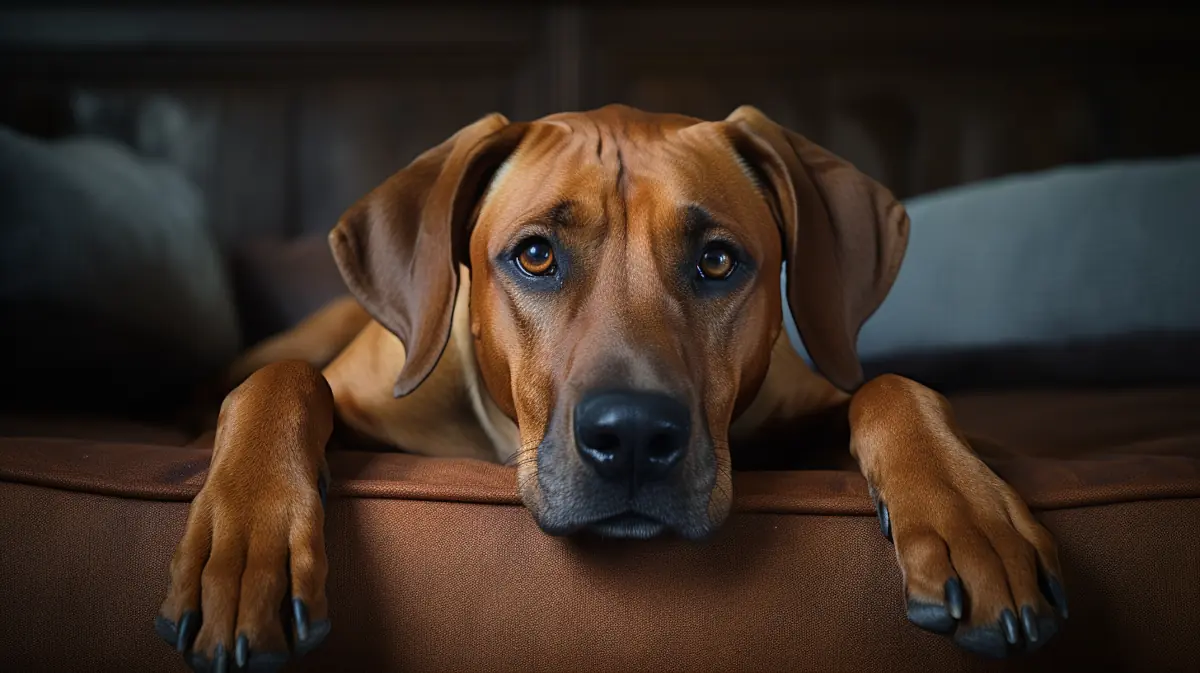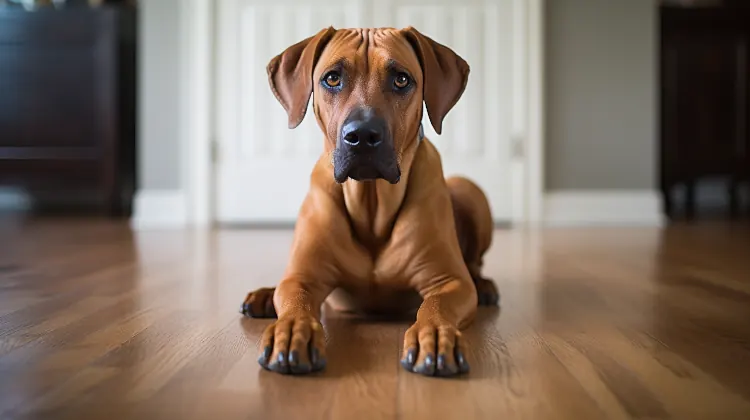Rhodesian Ridgebacks are a popular breed known for their distinctive ridge, a strip of hair that grows in the opposite direction along their back. However, some ridgeless individuals lack this characteristic physical trait within the Rhodesian Ridgeback breed. In this article, we will explore the concept of ridgeless Rhodesian Ridgebacks and delve into their definition, characteristics, and genetics behind this unique trait. We will also discuss how ridgelessness impacts breed standards and show competitions and the temperament and care tips for ridgeless Rhodesian Ridgebacks. Lastly, we will provide insights into finding ridgeless Rhodesian Ridgeback puppies and the importance of responsible breeders.
Table of contents
What is the Ridge Trait?
The ridge trait, also known as the characteristic ridge of hair along the back, is a defining feature of Rhodesian Ridgebacks. This unique trait sets them apart from other breeds. It is formed by a narrow strip of hair that grows in the opposite direction, creating a ridge-like appearance.
The ridge trait is inherited from ancestors and is genetically determined. Not all Rhodesian Ridgebacks possess this trait; some may be ridgeless. Ridgeless Rhodesian Ridgebacks are individuals without the hair ridge along their back.
The ridge trait follows a dominant gene pattern, meaning that inheriting one copy of the gene from either parent is enough for a Ridgeback to have the ridge. However, when two Ridgebacks with the ridge trait mate, there is a chance of producing a ridgeless puppy. This occurs when both parents carry one copy of the ridge gene, resulting in the puppy inheriting two copies of the non-ridge gene.
It’s important to remember that while the ridge trait is a notable characteristic in the Rhodesian Ridgeback breed standard, ridgeless Rhodesian Ridgebacks can still be fantastic, loving, and healthy companions. They exhibit similar temperaments and care requirements to Ridgebacks with the ridge trait.
When considering a Ridgeback puppy, whether with or without the ridge trait, it is crucial to find a responsible breeder who prioritizes the health and well-being of their dogs. Various considerations, including socialization, training, and exercise, should also be considered when adopting a Ridgeback puppy.
Ridgeless Rhodesian Ridgebacks: Definition and Characteristics
Ridgeless Rhodesian Ridgebacks are a unique variation of the Rhodesian Ridgeback breed that lack the distinctive ridge of hair along their back. They can still have the breed’s other traits.
Definition: A ridgeless Rhodesian Ridgeback is a Rhodesian Ridgeback with no characteristic ridge of hair along its back.
Characteristics: Ridgeless Rhodesian Ridgebacks share many of the same characteristics as their ridged counterparts. They are medium-sized, muscular dogs with short, dense coats that can range in color from wheaten to red. They have a strong, athletic build and are known for their endurance and agility. Ridgeless Ridgebacks also typically display the breed’s distinctive rounded ears and expressive, intelligent eyes.
Temperament-wise, ridgeless Ridgebacks tend to be loyal, affectionate, and protective. They are often friendly and outgoing with their family, but can be reserved with strangers. Like other Ridgebacks, they have a strong prey drive and may exhibit hunting instincts.
The occurrence of ridgeless Rhodesian Ridgebacks can be traced back to the early years of the breed’s development. Some Rhodesian Ridgebacks don’t have the characteristic ridge on their back due to a recessive gene. They can still be registered and participate in dog sports. However, they cannot compete in conformation shows, as the breed standard requires the ridge. Despite this, ridgeless Rhodesian Ridgebacks continue to bring joy and companionship to many families worldwide.
What Does “Ridgeless” Mean in Rhodesian Ridgebacks?

“Ridgeless” in Rhodesian Ridgebacks refers to a specific trait where the characteristic ridge along the dog’s back is missing. This rare trait can occur in Rhodesian Ridgeback litters and results in a smooth back without the distinctive ridge made up of hair growing in the opposite direction.
Despite not having the ridge, ridgeless Rhodesian Ridgebacks are still considered purebred and a natural variation within the breed. It is worth mentioning that they do not conform to the breed standard established by organizations such as the American Kennel Club (AKC). The ridge is one of the breed’s defining characteristics, which the AKC acknowledges.
It’s crucial to find a responsible breeder when considering adopting a ridgeless Rhodesian Ridgeback. The breeder should be able to provide information about the lineage and health of the puppies. Ridgeless Rhodesian Ridgebacks make great pets, even though they may not meet breed show standards.
Physical Characteristics
The physical characteristics of ridgeless Rhodesian Ridgebacks are distinct from those of the standard Rhodesian Ridgeback breed. Here is a table highlighting the key physical differences:
| Physical Characteristics of Ridgeless Rhodesian Ridgebacks | |
| Ridge on back | Absent |
| Fur | Short, dense |
| Head | Broad and flat |
| Ears | Moderately large, set high |
| Body | Well-muscled, balanced |
| Tail | Straight, tapering to the tip |
| Height | Typically between 24-27 inches at the shoulder |
| Weight | Usually between 70-85 pounds |
It is important to note that while ridgeless Rhodesian Ridgebacks lack the characteristic ridge along their back, they still possess the strong and athletic build typical of the breed. Their short and dense fur helps to regulate body temperature in various climates. The broad, flat head and moderately large ears set high contribute to their alert and confident appearance. Ridgeless Rhodesian Ridgebacks have a well-muscled and balanced body, allowing them to excel in various physical activities.
Regarding size, these dogs typically measure between 24-27 inches at the shoulder and weigh between 70-85 pounds. These physical characteristics make ridgeless Rhodesian Ridgebacks distinctive and attractive to those seeking a unique breed variation.
The Genetics behind Ridgelessness
.jpg?ssl=1)
The genetics behind ridgelessness in Rhodesian Ridgebacks can be explained through a table that outlines the inheritance pattern and the presence of the ridge gene.
| Inheritance Pattern | Ridge Gene |
| Incomplete Dominance | Present in ridgeless dogs |
| Present in ridged dogs | |
| Absent in ridgeless dogs |
In Rhodesian Ridgebacks, the inheritance pattern for ridgelessness is known as incomplete dominance. This means that the offspring will not have a fully developed ridge when a ridgeless dog is bred with a ridged dog. Instead, they may have a slight ridge or a patch of hair growing in the opposite direction. Only when two ridgeless dogs are bred together will they produce entirely ridgeless puppies.
The ridge gene is presence determines the ridge’s presence or absence in Rhodesian Ridgebacks. This gene is present in ridged dogs and absent in ridgeless dogs. When a ridgeless dog inherits the gene from one of its parents, the resulting offspring will have a ridge, but it will not be as well-defined as in ridged dogs.
Considering these genetic factors, breeders and owners should know that breeding two ridgeless dogs together consistently produces ridgeless offspring. However, breeding a ridgeless dog with a ridged dog can result in varied ridge development in the puppies.
To ensure the health and well-being of Rhodesian Ridgebacks, it is important for breeders and owners to have a thorough understanding of the genetics behind ridgelessness. This knowledge can guide responsible breeding practices and help maintain the breed’s distinct characteristics.
Homozygous vs. Heterozygous
Regarding ridgeless Rhodesian Ridgebacks, it’s important to understand the difference between homozygous and heterozygous ridgelessness. This can affect breeding programs and the likelihood of producing ridgeless puppies.
| Characteristic | Homozygous Ridgelessness | Heterozygous Ridgelessness |
|---|---|---|
| Inheritance | Both parents are ridgeless, and the puppy inherits two copies of the ridgelessness gene. | One parent is ridgeless, and the puppy inherits only one copy of the ridgelessness gene. |
| Ridgeless Offspring | All offspring will be ridgeless. | Approximately 50% of offspring will be ridgeless. |
| Genetic Testing | Genetic testing can confirm homozygous ridgelessness. | Genetic testing can confirm heterozygous ridgelessness. |
| Breeding Considerations | Homozygous ridgeless dogs should only be bred with ridged dogs to avoid potential health issues. | Heterozygous ridgeless dogs can be bred with ridged dogs to carefully manage the production of ridgeless puppies. |
Understanding the difference between homozygous and heterozygous ridgelessness is crucial for responsible breeding and preventing health concerns associated with ridgeless Rhodesian Ridgebacks. Genetic testing can help breeders make informed decisions and ensure the health and well-being of the breed.
How are Ridgeless Puppies Born in Rhodesian Ridgeback Litters?
- Ridgeless puppies in Rhodesian Ridgeback litters are born when both parents carry the recessive gene for ridgelessness.
- The ridgeless trait is inherited as an autosomal recessive trait, meaning both parents must carry the gene for ridgeless puppies to be born.
- When two Ridgeback parents who are carriers of the gene mate, there is a 25% chance that each puppy in the litter will be ridgeless.
- The gene responsible for ridgelessness in Rhodesian Ridgebacks is the KITLG gene.
- Ridgeless dogs can be registered and compete in competitions, but are not eligible for awards linked to the ridge characteristic.
- Although ridgeless puppies are born without the characteristic ridge on their back, they still possess the Rhodesian Ridgeback breed’s other physical and behavioral traits.
- Ridgeless puppies require the same care and training as Ridgeback puppies with ridges, including proper socialization, exercise, and consistent leadership.
- When adopting a Ridgeback puppy, it is important to consider whether you are prepared for the breed’s unique characteristics and care requirements, regardless of whether they have a ridge or not.
- Responsible breeders will provide information about the genetic history of their breeding dogs and any potential for ridgelessness in their litters.
- If you are specifically looking for a Ridgeback puppy without a ridge, it may be necessary to do some research and connect with breeders specializing in producing ridgeless puppies.
Breed Standards and the Ridge Trait

Breed Standards and the Ridge Trait – Let’s dive into the fascinating world of Ridgeless Rhodesian Ridgebacks! We’ll explore the role of the American Kennel Club in recognizing these unique canines and the impact of ridgelessness on Rhodesian Ridgeback show competitions.
The Role of the American Kennel Club in Recognizing Ridgeless Rhodesian Ridgebacks
- The AKC plays a significant role in recognizing ridgeless Rhodesian Ridgebacks by setting breed standards. This includes defining the physical characteristics and traits of specific dog breeds.
- Specifically for Rhodesian Ridgebacks, the AKC recognizes the ridge as an essential trait distinguishing them from other breeds.
- However, ridgeless Rhodesian Ridgebacks do not possess the signature ridge along their back.
- Even without a ridge, these dogs can still be registered with the AKC and take part in AKC-organized events and competitions.
- A Rhodesian Ridgeback without a ridge is still considered a member of the breed by the AKC.
AKC now recognizes ridgeless Rhodesian Ridgebacks, allowing for preservation and promotion of the breed’s variations.
Fact: Ridgeless Rhodesian Ridgebacks can demonstrate the same temperament and qualities that make this breed unique and beloved by many.
The Impact of Ridgelessness on Rhodesian Ridgeback Show Competitions
The impact of ridgelessness on Rhodesian Ridgeback show competitions is significant. They are not eligible to compete in standard show competitions because the ridge trait is a distinguishing characteristic of the breed. Dogs without ridges do not possess this trait. This exclusion from show competitions can have implications for breeders who are striving to produce dogs that meet the breed standard. Breeders must exercise selectivity in choosing mating pairs to avoid the birth of ridgeless puppies, which is a flaw in the breed. The presence of ridgeless dogs in a breeding program can also affect the overall quality of the breed. It is important for breeders to prioritize preserving the ridge trait and maintaining the desired characteristics and temperament of Rhodesian Ridgebacks.
However, ridgeless Rhodesian Ridgebacks can still participate in other non-show activities such as obedience trials or sports competitions. These activities provide an avenue for ridgeless dogs to showcase their abilities and intelligence.
Frequently Asked Questions
What is a Ridgeless Rhodesian Ridgeback?
A Ridgeless Rhodesian Ridgeback is a Rhodesian Ridgeback dog that is born without the characteristic ridge of hair along its spine. It is a genetic mutation that some dogs in the breed possess.
What is the significance of the ridge on Rhodesian Ridgebacks?
The ridge on Rhodesian Ridgebacks has cultural and historical significance. It distinguishes the breed from other similar-looking dogs and has been a defining characteristic for many years in the breed’s culture.
Are Ridgeless Rhodesian Ridgebacks considered defects?
No, Ridgeless Rhodesian Ridgebacks were once considered defects, but modern breeders now see them as wonderful, loving pets. They have the same temperament as their ridged counterparts.
Do Ridgeless Rhodesian Ridgebacks have any health risks?
Ridgeless Rhodesian Ridgebacks can potentially have health risks, such as an increased risk of Dermoid sinus, a neural-tube defect. However, it is important to consult a veterinarian for any specific health concerns or advice regarding this breed.
Can Ridgeless Rhodesian Ridgebacks participate in dog shows?
No, ridgelessness is considered a disqualification in dog shows. However, they can still participate in other competitions and activities.
What is the population of Ridgeless Rhodesian Ridgebacks?
Ridgeless Rhodesian Ridgebacks are less common, with about 1 in 20 puppies being born ridgeless. Breeders typically remove these dogs from the gene pool, either euthanizing them or placing them as pets with the condition that they will be spayed or neutered.





